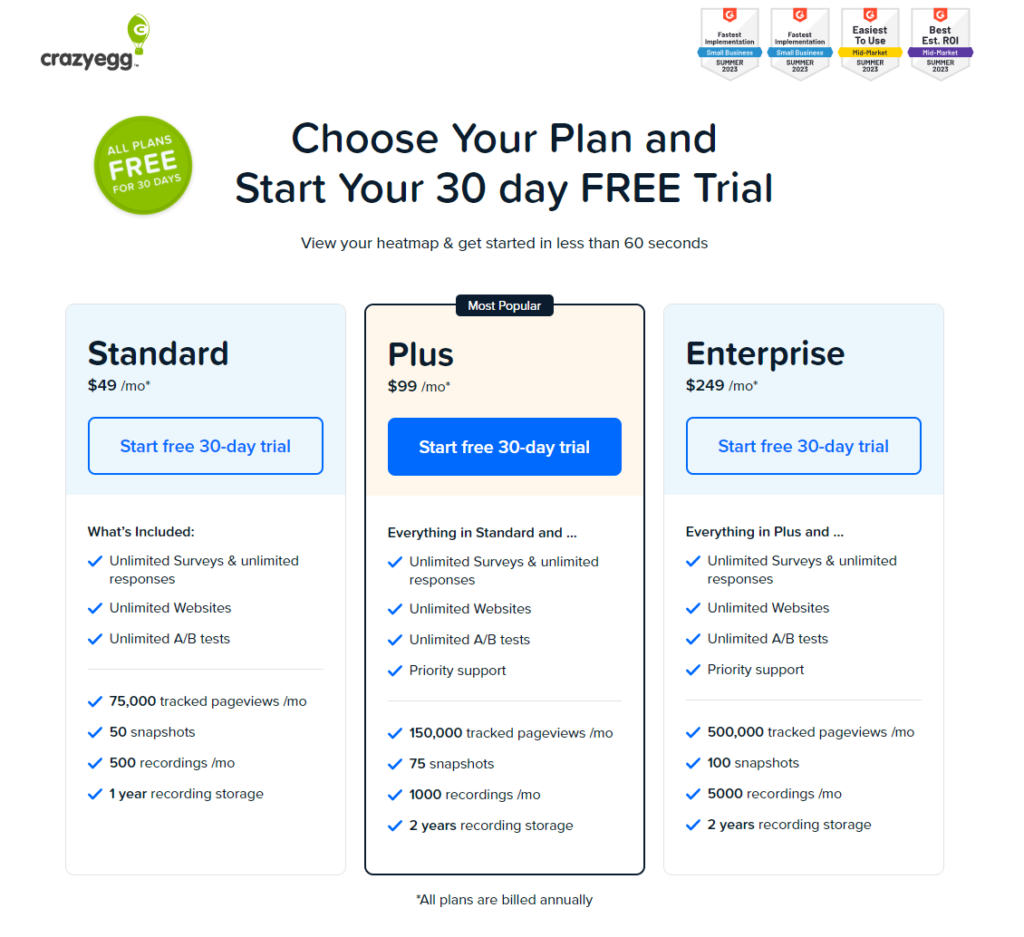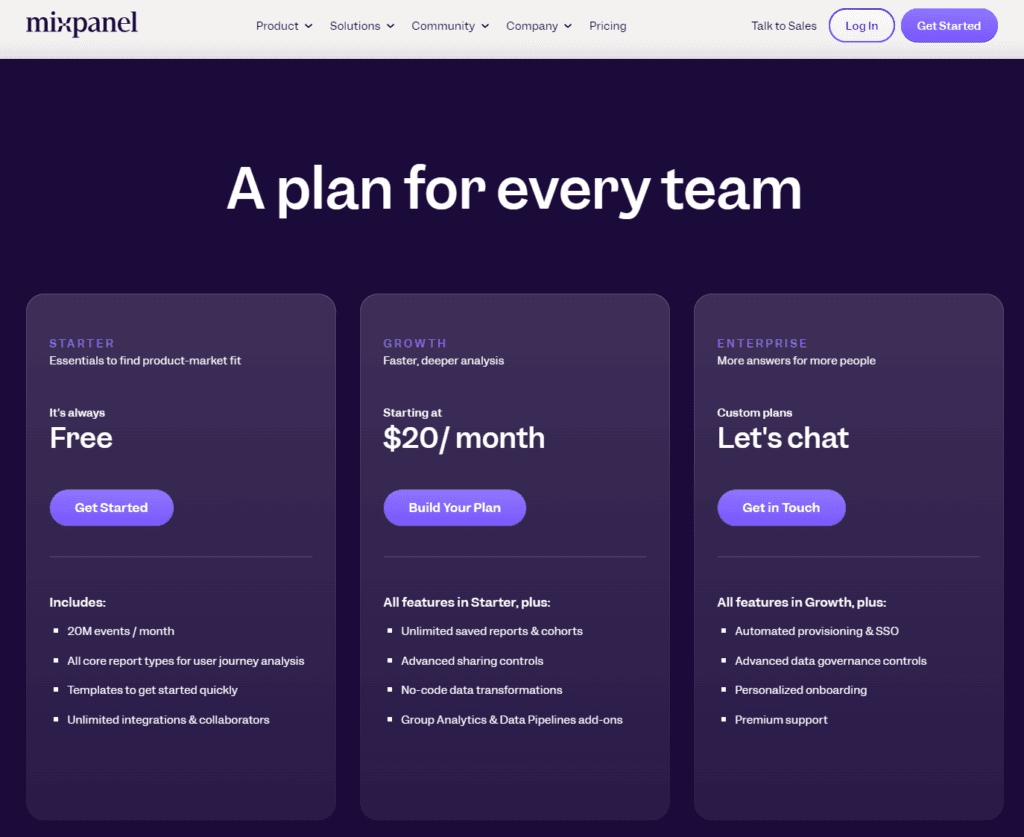In the bustling digital marketplace, navigating the complex world of website analytics can often feel like trying to find your way through a dense forest without a compass. Enter Crazy Egg and Mixpanel, two leading lights in the analytics sphere, each offering unique insights to guide you on your journey. But which one is the shining beacon for your path to data-driven success? Whether you’re a small business owner keen on improving your site’s user experience or a product manager looking to dive deep into customer behavior analytics, choosing the right tool can significantly impact your online strategy.
Crazy Egg | Mixpanel |
|---|---|
| G2 Score – 4.2 out of 5 stars | G2 Score – 4.6 out of 5 stars |
| TrustRadius Score – 7.6/10 | TrustRadius Score – 8.4/10 |
User Behavior Insights
Understanding how users interact with your website or app is pivotal for any business. It’s not just about tracking page views; it’s about decoding the story behind each click and scroll. Here’s how Crazy Egg and Mixpanel perform in shining a light on user behavior.
Crazy Egg:
With its suite of visual analytics tools, including heatmaps, scroll maps, and session recordings, Crazy Egg offers a window into your visitors’ journey through your site. These tools allow you to see not just where users click but how they navigate your content, providing clear, actionable insights. Crazy Egg excels in simplifying the complex, translating vast amounts of data into easy-to-understand visual formats.
This approach is especially valuable for website optimization, making it easier to identify bottlenecks, improve user experience, and ultimately, increase conversion rates. Crazy Egg’s strength lies in its ability to offer direct, visual insights into user interaction, making it an excellent tool for those focused on enhancing their website’s user engagement and usability.
Mixpanel:
Going beyond traditional page-level analytics, Mixpanel offers a deep dive into user behavior with event-based tracking. This allows for a granular analysis of how users interact with your website or application, from the actions they take to the sequences that lead to conversion or drop-off. Mixpanel’s ability to segment users and analyze funnels provides a comprehensive view of the customer journey, offering insights that can inform not just website design but product development and marketing strategies as well.
With Mixpanel, businesses can track specific events, understand user engagement patterns, and make data-driven decisions to foster growth. Its robust analytics capabilities make Mixpanel a powerful tool for businesses looking to gain in-depth insights into user behavior and drive targeted improvements.
Integration Capabilities
The ability for an analytics tool to play well with other software in your marketing and product tech stack is not just a convenience; it’s a necessity for holistic analysis and streamlined workflows. Here’s how Crazy Egg and Mixpanel compare in their ability to integrate with other digital tools. In today’s digital ecosystem, an analytics tool’s ability to seamlessly integrate with other platforms and services can significantly enhance its utility and the insights it provides.
Crazy Egg:
Crazy Egg focuses on providing a straightforward and intuitive solution for understanding user behavior on websites through visual analytics. Its integration capabilities are primarily centered around ease of installation on a wide range of websites. Crazy Egg can be quickly added to most websites with a simple piece of JavaScript, and it offers specific plugins or easy integration guides for popular content management systems like WordPress, Shopify, and others.
While Crazy Egg excels in collecting detailed user interaction data on your site, its direct integrations with other digital marketing tools or CRM platforms are more limited. This focus ensures that Crazy Egg remains a specialized tool for optimizing website user experience but may require additional steps or tools to integrate this data with broader marketing or customer insights.
Mixpanel:
In contrast, Mixpanel offers extensive integration capabilities designed to fit seamlessly into a broader digital ecosystem. Recognizing the importance of event-based data across different platforms, Mixpanel supports integrations with a wide variety of tools, including marketing automation platforms, CRM systems, and even other analytics services.
This allows businesses to not only track user behavior on their site or app but also to correlate this data with other key metrics and systems, providing a comprehensive view of the customer journey. Mixpanel’s API and extensive partnership ecosystem make it a highly adaptable tool, capable of supporting detailed analytics strategies that require data from multiple sources.

Related: Check out our free SEO suite

Data Analysis and Reporting Capabilities
The power of an analytics tool is not just in the data it collects but in how it interprets this data, making it accessible and actionable for its users. Here’s how Crazy Egg and Mixpanel measure up in their ability to analyze data and deliver meaningful reports. Effective data analysis and insightful reporting are at the heart of any analytics tool, turning raw data into actionable insights that can shape decision-making and strategy.
Crazy Egg:
Crazy Egg specializes in visual data analysis, offering an array of tools like heatmaps, scroll maps, and session recordings that provide a clear picture of how users interact with your website. This visual approach simplifies the analysis, making it easy for users to understand user behavior at a glance and identify areas for improvement. Crazy Egg’s reports are designed to be intuitive, focusing on visual insights that can quickly inform website design and content strategy.
However, while highly effective for understanding on-page behavior, Crazy Egg’s reporting capabilities are primarily qualitative, offering less in the way of quantitative analysis or deep dives into user segmentation and conversion funnels.
Mixpanel:
Mixpanel, on the other hand, offers comprehensive data analysis capabilities, with a strong emphasis on event-based tracking and user segmentation. It provides detailed insights into how users interact with your site or application, tracking every action (or “event”) that users perform. This enables a deep understanding of user journeys, conversion paths, and retention rates.
Mixpanel’s reporting features are robust, offering customizable dashboards, funnel analysis, and cohort studies that can be tailored to specific business questions. Its ability to segment users based on behavior and to analyze data across different dimensions makes Mixpanel a powerful tool for businesses looking for detailed, actionable insights into user behavior and marketing effectiveness.
User Segmentation and Personalization Capabilities
Segmenting users allows businesses to tailor their strategies to different audience behaviors and preferences, a crucial element in optimizing user experience and marketing effectiveness. Here’s how Crazy Egg and Mixpanel enable user segmentation and personalization. The ability to segment users based on their behavior and personalize their experiences can significantly enhance engagement and conversion rates. Understanding how Crazy Egg and Mixpanel tackle this can provide deeper insights into which tool might best serve your needs.
Crazy Egg:
While primarily known for its heatmap, scroll map, and session recording features, Crazy Egg provides basic segmentation capabilities that allow you to filter and understand how different user groups interact with your website. These insights can help identify patterns or issues specific to certain segments, informing targeted optimizations. However, Crazy Egg’s core strength lies in visual analytics rather than deep user segmentation or personalization. Its capabilities are most suited for businesses looking to improve their website’s overall user experience and conversion rates by understanding general user behavior patterns.
Mixpanel:
Mixpanel excels in user segmentation and personalization capabilities, offering a robust platform for analyzing detailed user behavior and crafting personalized user experiences. With Mixpanel, businesses can track a wide range of user actions (events) and segment users based on these actions, demographic information, and other custom properties. This enables a deep understanding of how different segments interact with your product or website, supporting targeted marketing campaigns, personalized content, and product features.
Mixpanel’s strength in segmentation and personalization is particularly beneficial for businesses aiming to increase engagement, retention, and conversion through tailored user experiences.
Comparing the User Segmentation and Personalization Capabilities of Crazy Egg and Mixpanel, Mixpanel offers a more advanced solution designed for businesses focused on leveraging detailed user data to drive personalization and targeted strategies. Crazy Egg provides valuable insights into user behavior on your website, which can indirectly inform segmentation and personalization efforts, but lacks the depth of Mixpanel’s event-based tracking and segmentation features.
Pricing and Value Proposition
Choosing the right analytics tool isn’t just about features; it’s also about finding a solution that offers the best value within your budget. Here’s a closer look at how Crazy Egg and Mixpanel position themselves in terms of pricing and the value they deliver to businesses.
Crazy Egg:
Crazy Egg offers a range of pricing tiers to accommodate businesses of various sizes, from small startups to larger enterprises. Its plans are designed to be affordable, with the basic tier providing access to core features like heatmaps, scroll maps, and session recordings. The pricing structure is transparent, allowing businesses to select a plan that matches their needs without overcommitting resources.
This accessibility makes Crazy Egg particularly appealing to businesses that need straightforward, visual insights to optimize their website without a significant investment. The value proposition of Crazy Egg lies in its ease of use and the immediate, actionable insights it provides, making it a cost-effective solution for enhancing website user experience and conversion rates.
Mixpanel:
Mixpanel’s pricing model is based on the volume of data tracked, reflecting its comprehensive analytics capabilities. While potentially more expensive than simpler analytics solutions, Mixpanel offers a depth of analysis and segmentation that can justify the higher cost for businesses focused on detailed user behavior tracking and personalization.
The platform is particularly valuable for companies that require advanced analytics to inform product development, marketing strategies, and customer experience improvements. Mixpanel’s value proposition centers on its ability to provide granular insights into user actions, supporting data-driven decision-making that can lead to significant improvements in engagement, retention, and revenue.
Pricing
Crazy Egg:

Mixpanel:

Conclusion
Concluding our exploration of Crazy Egg and Mixpanel, it’s evident that both platforms offer valuable insights but cater to different needs and budgets within the analytics landscape.
Crazy Egg shines with its focus on visual analytics, offering an accessible and straightforward way to understand user behavior on your website. It’s an ideal choice for small to medium-sized businesses or anyone seeking to quickly identify and act on website optimization opportunities without a hefty investment. Crazy Egg’s affordability and ease of use make it a practical tool for enhancing website user experience and conversion rates through direct, visual insights.
Mixpanel, on the other hand, stands out for its comprehensive analytics capabilities, particularly in user segmentation and event tracking. It offers a depth of analysis that can significantly impact product development, marketing strategies, and personalized user experiences. Suitable for businesses ready to invest in a detailed understanding of their users’ behavior, Mixpanel provides granular insights that support informed, data-driven decisions across multiple aspects of a business.
Read Next:
- GetResponse vs Zoho Campaigns: The Best Email Marketing Tool for 2024
- AWeber vs ActiveCampaign: The Best Email Marketing Tool
- Constant Contact vs Campaigner: Best Email Marketing Tool
- GetResponse vs Omnisend: The Best Email Marketing Tool for 2024
- AWeber vs Benchmark Email: The Best Email Marketing Tool





















Comments are closed.